Jack Williamson
| Jack Williamson | |
|---|---|
 Williamson, copyright 2003 | |
| Born |
John Stewart Williamson April 29, 1908 Bisbee, Arizona Territory, USA |
| Died |
November 10, 2006 (aged 98) Portales, New Mexico, USA |
| Pen name |
Will Stewart Nils O. Sonderlund |
| Occupation | Writer, Professor of English |
| Nationality | American |
| Period | 1928–2006[1] |
| Genre | Science fiction |
John Stewart Williamson (April 29, 1908 – November 10, 2006), who wrote as Jack Williamson, was an American science fiction writer, often called the "Dean of Science Fiction" after the death of Robert Heinlein in 1988.[2] Early in his career he sometimes used the pseudonyms Will Stewart and Nils O. Sonderlund.[1]
Early life
Williamson was born April 29, 1908 in Bisbee, Arizona Territory, and spent his early childhood in western Texas. In search of better pastures, his family migrated to rural New Mexico in a horse-drawn covered wagon in 1915.[3] The farming was difficult there and the family turned to ranching, which they continue to this day. He served in the U.S. Army Air Corps in World War II as a weather forecaster.
Writing career
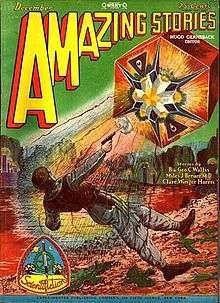

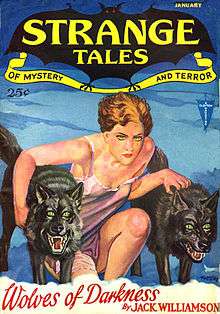
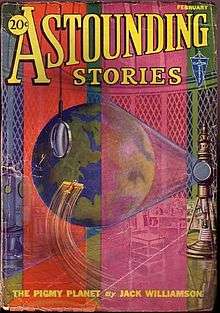
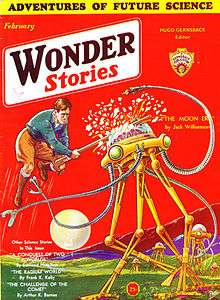
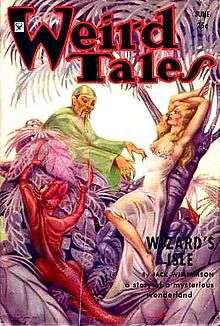
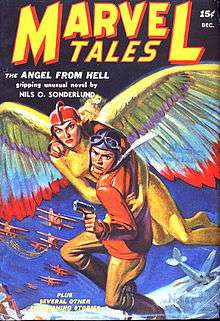
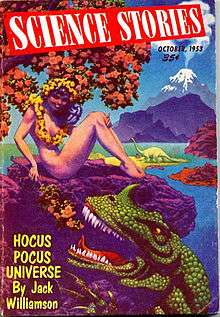

As a child Williamson enjoyed storytelling to his brother and two sisters. As a young man, he discovered the magazine Amazing Stories, established in 1926 by Hugo Gernsback, after answering an ad for one free issue. He strove to write his own fiction and sold his first story to Gernsback at age 20: "The Metal Man" was published in the December 1928 issue of Amazing.[1] During the next year Gernsback published three more of his stories in the new pulp magazines Science Wonder Stories and Air Wonder Stories, and separately published "The Girl from Mars" by Miles J. Breuer and Williamson as Science Fiction Series #1.[1] His work during this early period was heavily influenced by A. Merritt,[4] author of The Metal Monster (1920) and other fantasy serials. Noting the Merritt influence, Algis Budrys described "The Metal Man" as "a story full of memorable images".[5]
Early on, Williamson became impressed by the works of Miles J. Breuer and struck up a correspondence with him. A doctor who wrote science fiction in his spare time, Breuer had a strong talent and turned Williamson away from dreamlike fantasies towards more rigorous plotting and stronger narrative. Under Breuer's tutelage, Williamson would send outlines and drafts for review.[3] Their first work together was the novel Birth of a New Republic in which Moon colonies were undergoing something like the American Revolution—a theme later taken up by many other SF writers, particularly in Robert A. Heinlein's The Moon Is a Harsh Mistress.
Wracked by emotional storms and believing many of his physical ailments to be psychosomatic, Williamson underwent psychiatric evaluation in 1933 at the Menninger Clinic in Topeka, Kansas, in which he began to learn to resolve the conflict between his reason and his emotion.[3] From this period, his stories take on a grittier, more realistic tone.
By the 1930s he was an established genre author, and the teenaged Isaac Asimov was thrilled to receive a postcard from Williamson, whom he had idolized, which congratulated him on his first published story and offered "welcome to the ranks".[3] Williamson remained a regular contributor to the pulp magazines but did not achieve financial success as a writer until many years later.
An unfavorable review of one of his books, which compared his writing to that of a comic strip, brought Williamson to the attention of The New York Sunday News, which needed a science fiction writer for a new comic strip. Williamson wrote the strip Beyond Mars (1952–55), loosely based on his novel Seetee Ship, until the paper dropped all comics.
Beginning 1954 and continuing into the 1990s, Williamson and Frederick Pohl wrote more than a dozen science fiction novels together, including the series Jim Eden, Starchild, and Cuckoo.[1] Williamson continued to write as a nonagenarian and won both the Hugo and Nebula Awards during the last decade of his life, by far the oldest writer to win those awards.[3][6]
In his later years, he would also criticize attempts to write "serious" science fiction:[7]
Maybe because of my own background of writing commercial SF for so many years, I have a great deal of respect for good craftsmanship of the sort that commercial writers must develop. The labels you hear so much of—"commercial," "serious writer," "mainstream," "hack," "New Wave," "experimental"—are usually very misleading.In my own field, Ed Hamilton and Hank Kuttner and more recently Bob Silverberg are all writers who formed a fine command of the SF genre early in their careers and who later on used this to do work that is more consciously "literary" and hence more admired by critics. But certainly the writing they did earlier was deservedly popular among SF fandom, who evidently found these works "serious" enough to merit reading.
I am opposed, however, to literary tricks that tend towards obscurity or artificial difficulty, though I can see arguments for that kind of approach. My own experience as a teacher of writing confirms my sense that new authors with artistic ambitions may find themselves scorning too many of the old forms and patterns simply because they blindly associate them with hack work. The point is that these patterns and structures form the basic vocabulary through which all SF writers must speak. That's one reason I'm not completely sympathetic with contemporary writers like Silverberg and Chip Delany and Tom Disch, who are clearly aiming to get themselves recognized as "serious" or mainstream authors.
Academic career
Williamson received his Bachelor of Arts and Master of Arts degrees in English in the 1950s from Eastern New Mexico University (ENMU) in Portales (near the Texas panhandle), joining the faculty of that university in 1960. He remained affiliated with the school for the rest of his life. In the late 1990s, he established a permanent trust to fund the publication of El Portal, ENMU's journal of literature and art.[8] In the 1980s, he made a sizable donation of books and original manuscripts to ENMU's library, which resulted in the formation of a Special Collections department; the library now is home to the Jack Williamson Science Fiction Library, which ENMU's website describes as "one of the top science fiction collections in the world".[9] In addition, Williamson hosted the Jack Williamson Lectureship Series, an annual panel discussion in which two science fiction authors were invited to speak to attendees on a set topic. The Jack Williamson Liberal Arts building houses the Mathematics, Art, and Languages & Literature Departments of the university.
Williamson completed his Ph.D. in English literature at the University of Colorado in Boulder, focused on H.G. Wells' earlier works, demonstrating that Wells was not the naive optimist that many believed him to be. In the field of science, Jack Williamson coined the word terraforming in a science-fiction story published in 1942 in Astounding Science Fiction.[10]
Later years
The Science Fiction Writers of America named Williamson its second Grand Master of Science Fiction after Robert Heinlein, presented 1976.[11][12]
After retiring from teaching full-time in 1977, Williamson spent some time concentrating on his writing, but after being named Professor Emeritus by ENMU, he was coaxed back to co-teach two evening classes, "Creative Writing" and "Fantasy and Science Fiction" (he pioneered the latter at ENMU during his full-time professorship days). Williamson continued to co-teach these two classes into the 21st century. After he made a large donation of original manuscripts and rare books from his personal collection to the ENMU library, a special collections area was created to house these and it was named the "Jack Williamson Special Collection".
In 1994 Williamson received a World Fantasy Award for Lifetime Achievement.[11][13]
The Science Fiction and Fantasy Hall of Fame inducted Williamson in 1996, its inaugural class of two deceased and two living persons.[11][14]
The Horror Writers Association conferred its Bram Stoker Award for Lifetime Achievement in 1998[15] and the World Horror Convention elected him Grand Master in 2004.[11]
In November 2006, Williamson died at his home in Portales, New Mexico at age 98.[16] Despite his age, he had made an appearance at the Spring 2006 Jack Williamson Lectureship and published a 320-page novel, The Stonehenge Gate, in 2005.
Legion of Space series
While attending a Great Books course, Williamson learned that Henryk Sienkiewicz had created one of his works by taking The Three Musketeers of Alexandre Dumas and pairing them with John Falstaff of William Shakespeare. Williamson took this idea into science fiction with The Legion of Space.
Desperate for money, he searched for a quick source of income. While most pulps of the time were slow to pay, the recently restarted Astounding was an exception. However, they did not accept novels, so Williamson submitted three short stories and a novelette. Learning that they were also accepting novels for serialization, he sent in The Legion of Space, which was published in six parts. It quickly became a genre favorite, and was quickly collected into a hardcover.
The story takes place in an era when humans have colonized the Solar System but dare not go farther, as the first extra-solar expedition to Barnard's Star failed and the survivors came back as babbling, grotesque, diseased madmen. They spoke of a gigantic planet, populated by ferocious animals and the single city left of the evil "Medusae". The Medusae bear a vague resemblance to jellyfish, but are actually elephant-sized, four-eyed, flying beings with hundreds of tentacles. The Medusae cannot speak and communicate with one another via a microwave code.
The Falstaff character is named Giles Habibula. He was once a criminal, and can open any lock ever made. In his youth he was called Giles The Ghost. Jay Kalam (Commander of The Legion) and Hal Samdu are the names of the other two warriors. In this story, these warriors of the 30th Century battle the Medusae, the alien race from the lone planet of Barnard's Star. The Legion itself is the military and police force of the Solar System after the overthrow of an empire called the Purple Hall that once ruled all humans.
In this novel, renegade Purple pretenders ally themselves with the Medusae as a means to regain their empire. But the Medusae, who are totally unlike humans in all ways, turn on the Purples, seeking to destroy all humans and move to the Solar System, as their own world, far older than Earth, is finally spiraling back into Barnard's Star. One of the Purples, John Ulnar, supports the Legion from the start, and he is the fourth great warrior. His enemy is the Purple pretender Eric Ulnar, who sought the Medusae out in the first place, seeking to become the next Emperor of The Sun.
The Medusae conquered the Moon, set up their bases there, and went on to attempt conquest of the Solar System. The Medusae had for eons used a reddish, artificial greenhouse gas to keep their dying world from freezing. The Medusae learned from the first human expedition to their world that the gas rots human flesh, and the Medusae use it as a potent chemical weapon, attempting ecological destruction by means of projectiles fired from the Moon. Their vast spaceships also have very effective plasma weapons, very similar to those the Romulans had in a Star Trek episode called Balance of Terror.
The Legion works also featured a force field called AKKA which can erase from the Universe any matter, of any size, anywhere, even a star or a planet. AKKA was a weapon of mass destruction and the secret of it was entrusted to a series of women. AKKA was used in the past to overthrow the Purple tyranny. It was also used to wipe out most of the Medusae, though they had tried to steal the secret. When they were wiped out, the Moon where they had established their base was erased out of existence. At the end of the story, John Ulnar falls in love with the keeper of AKKA, Aladoree Anthar, and marries her. Aladoree Anthar is described as a young woman with lustrous brown hair and gray eyes, beautiful as a goddess.
Williamson next wrote The Cometeers which takes place twenty years after The Legion of Space in which the same characters battle another alien race, this one of different origin.
In this second tale, they fight The Cometeers who are an alien race of energy beings controlling a "comet" which is really a giant force field containing a swarm of planets populated by their slaves. The slave races are of flesh and blood, but none are remotely similar to humans. The Cometeers cannot be destroyed by AKKA, as they are incorporeal from the Universe's point of view and exist for the most part in an alternate reality. The ruling Cometeers feed on their slaves and literally absorb their souls, leaving disgusting, dying hulks in their wake. It is said that they do so, as they were once fleshly entities themselves of various species. Hence, the ruling Cometeers keep other intelligent beings as slaves and "cattle". They fear AKKA, though, as it can erase all their possessions.
They are defeated by the skills of Giles Habibula. Giles broke into a secret chamber guarded by complex locks and force fields that the incorporeal Cometeers could not penetrate. In it the ruler of the Cometeers had kept its own weapon of mass destruction, one that would cause the Cometeers to disintegrate. The ruling Cometeer kept this weapon to enforce its rule over the others of its kind. Once the Cometeers were destroyed, their slaves were ordered by the Legion to take the comet and leave the Solar System, and never return.
Another novel, One Against the Legion, tells of a Purple pretender who sets up a robotic base on a world over seventy light years from Earth, and tries to conquer the Solar System via matter transporter technology he has stolen. In this story robots are outlawed, as they are in Dune. The story also features Jay Kalam, lobbying to allow the New Cometeers to leave the Solar System in peace, as many people were demanding that AKKA be used to obliterate the departing swarm of planets once and for all.
In 1983, Williamson published a final Legion novel, The Queen of the Legion. Giles Habibula reappears in this final novel, which is set after the disbanding of the Legion.
Works
Series
- The Legion of Space (1947; six-part serial in Astounding, 1934)
- The Cometeers (1950; four-part serial in Astounding, 1936, plus One Against the Legion, three-part serial in Astounding, 1939)
- One Against the Legion (1967; three-part serial in Astounding, 1939, plus "Nowhere Near")
- Three from the Legion (1980; omnibus of three novels plus "Nowhere Near")
- The Queen of the Legion (1983)
- Humanoids Series
- With Folded Hands (1947; in Astounding)
- The Humanoids (1949; three-part serial as "...And Searching Mind" in Astounding, 1949)
- The Humanoid Touch (1980)
- The Humanoids / With Folded Hands (1996; omnibus)
- Seetee Series
An editor suggested that Williamson combine the ideas of contraterrene matter (antimatter) and asteroid mining, which inspired the Seetee (C-T) series of short stories written as Will Stewart.
- Seetee Shock (1949; as by Will Stewart; from Astounding, 1949)
- Seetee Ship (1951; as by Will Stewart; from previously published stories 1942–3)
- Seetee Ship/Seetee Shock (1971)
- Undersea Trilogy (with Frederik Pohl)
- Undersea Quest (1954)
- Undersea Fleet (1956)
- Undersea City (1958)
- The Undersea Trilogy (1992; omnibus)
- Saga of Cuckoo (with Frederik Pohl)
- Farthest Star (1975)
- Wall Around A Star (1983)
- Starchild Trilogy (with Frederik Pohl)
- The Reefs of Space (1964)
- Starchild (1965)
- Rogue Star (1969)
- The Starchild Trilogy (1977; omnibus)
Novels
- The Girl from Mars (1930, with Miles J. Breuer)
- The Green Girl (1930)
- Golden Blood (1933)
- Xandulu (1934)
- The Blue Spot (1935)
- Islands of the Sun (1935)
- Reign of Wizardry (1940) (loosely based on the story of Theseus from Greek mythology)
- Darker Than You Think (1948)
- Dragon's Island (1951; also known as The Not-Men)
- Star Bridge (1955, with James E. Gunn)
- The Dome Around America (1955; also known as Gateway to Paradise)
- The Trial of Terra (1962; from four previously published stories, 1951–1962)
- Bright New Universe (1967)
- Trapped in Space (1968)
- The Moon Children (1972)
- The Power of Blackness (1975)
- Brother to Demons, Brother to Gods (1979; from five previously published stories, 1977–78)
- Manseed (1982)
- Lifeburst (1984)
- Firechild (1986)
- Land's End (1988, with Frederik Pohl)
- Mazeway (1990)
- The Singers of Time (1991, with Frederik Pohl)
- Beachhead (1992)
- Demon Moon (1994)
- The Black Sun (1997)
- The Fortress of Utopia (1998; originally in Startling Stories, 1939)
- The Silicon Dagger (1999)
- The Stone from a Green Star (1999; originally in Amazing Stories, 1931)
- Terraforming Earth (2001; Co-winner of 2002 John W. Campbell Memorial Award)
- The Stonehenge Gate (2005)
Collections
- The Legion of Time, and After World's End (1952)
- The Pandora Effect (1969)
- People Machines (1971)
- The Early Williamson, 1975
- The Best of Jack Williamson (1978)
- The Alien Intelligence (1980)
- Millions de Soleils (1988)
- Into the Eighth Decade (1990)
- The Prince of Space/The Girl from Mars (1998; TGFM written with Miles J. Breuer)
- The Collected Stories of Jack Williamson, Volume One, The Metal Man and Others (1999)
- The Collected Stories of Jack Williamson, Volume Two, Wolves of Darkness (1999)
- The Blue Spot, and Entropy Reversed (Released Entropy) (2000; both from Astounding, 1937)
- The Collected Stories of Jack Williamson, Volume Three, Wizard's Isle (2000)
- Dragon's Island and other stories (2002; novel and two shorts)
- The Collected Stories of Jack Williamson, Volume Four, Spider Island (2002)
- Seventy-Five: The Diamond Anniversary of a Science Fiction Pioneer, Stephen Haffner & Richard A. Hauptmann, eds. (2004)
- The Collected Stories of Jack Williamson, Volume Five, The Crucible of Power (2006)
- In Memory of Wonder's Child Stephen Haffner, ed. (2007)
- The Worlds of Jack Williamson: A Centennial Tribute (1908–2008), Stephen Haffner, ed. (2008)
- The Collected Stories of Jack Williamson, Volume Six, Gateway to Paradise (2008)
- With Folded Hands… And Searching Mind, The Collected Stories of Jack Williamson, Volume Seven (2010)
- At the Human Limit, The Collected Stories of Jack Williamson, Volume Eight (2011)
Short stories
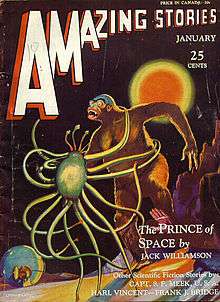
- The Metal Man (1928)
- The Cosmic Express (1930)
- The Moon Era (1931)
- Born of the Sun (1934)
- Star Bright (1939)
- The Angel From Hell (1939; in Marvel Tales, writing as Nils O. Sonderlund)
- Hindsight (1940)
- Collision Orbit (1942; writing as Will Stewart; into Seetee Ship)
- Minus Sign (1942; writing as Will Stewart; into Seetee Ship)
- Opposites—React! (1943; writing as Will Stewart; into Seetee Ship)
- With Folded Hands... (1947)
- The Man from Outside (1951)
- Beans (1958)
- Jamboree (1969)
- The Highest Dive (1976)
- The Humanoid Universe (1980)
- The Firefly Tree (1997)
- The Pet Rocks Mystery (1998)
- Eden Star (2000)
- The Ultimate Earth (2000; awarded the Hugo for Best Novella in 2001)
| Title | Year | First published in | Reprinted in |
|---|---|---|---|
| Afterlife | 2002 | F&SF | Year's Best SF 8 |
Autobiography
- Wonder's Child: My Life in Science Fiction. Bluejay Books, New York, 1984. (Hardcover)[6]
- Wonder's Child: My Life in Science Fiction. Benbella Books, Dallas, 2005. (Paperback, updated with new photographs and epilogue)
Bibliography
- The Works of Jack Williamson: An Annotated Bibliography and Guide, Richard A. Hauptmann (NESFA Press, 1997)
See also
- Android
- Anti-matter
- Genetic engineering—Williamson invented this term in Dragon's Island and it has since passed into common use
- Psionics
- Space opera
- Terraforming
References
- 1 2 3 4 5 Jack Williamson at the Internet Speculative Fiction Database (ISFDB). Retrieved 2013-03-24. Select a title to see its linked publication history and general information. Select a particular edition (title) for more data at that level, such as a front cover image or linked contents.
- ↑ "Jack Williamson, Greg Bear: Two SFWA pillars honored with 2006 Heinlein Award". SFWA Pressbook. Retrieved 2007.
- 1 2 3 4 5 Williamson, Jack. Wonder's Child: My Life in Science Fiction (Benbella Books, 2005)
- ↑ Moskowitz, Sam. "Jack Williamson: Four-Way Pioneer". Amazing Stories, October 1964.
- ↑ "Galaxy Bookshelf", Galaxy Science Fiction, December 1967, p. 190.
- 1 2 Fox, Margalit (November 14, 2006). "Jack Williamson, 98, an Author Revered in Science Fiction Field, Dies". The New York Times. Archived from the original on 2011-03-17. Retrieved 2011-03-17.
In 1985, Mr. Williamson received a Hugo Award for his memoir, 'Wonder’s Child: My Life in Science Fiction' (Bluejay Books, 1984). His 2001 novella 'The Ultimate Earth' won a Hugo, given by the World Science Fiction Society, and a Nebula Award, given by the Science Fiction and Fantasy Writers of America.
- ↑ Science Fiction Studies - An Interview with Jack Williamson
- ↑ "Jack Williamson: El Portal". Eastern New Mexico University. Retrieved June 16, 2015.
- ↑ "Jack Williamson Science Fiction Library". Golden Library Special Collections. Eastern New Mexico University (ENMU). Retrieved 2007.
- ↑ "Science Fiction Citations: terraforming". Unknown (jessesword.com). Retrieved 2006-06-16.
- 1 2 3 4 "Williamson, Jack". The Locus Index to SF Awards: Index of Literary Nominees. Locus Publications. Retrieved 2013-03-24.
- ↑ "Damon Knight Memorial Grand Master". Science Fiction and Fantasy Writers of America (SFWA). Retrieved 2013-03-24.
- ↑ World Fantasy Convention. "Award Winners and Nominees". Archived from the original on December 1, 2010. Retrieved 2011-02-04.
- ↑ "Science Fiction and Fantasy Hall of Fame" Archived May 21, 2013, at the Wayback Machine.. Mid American Science Fiction and Fantasy Conventions, Inc. Retrieved 2013-03-24. This was the official website of the hall of fame to 2004.
- ↑ "Bram Stoker Award for Lifetime Achievement". Horror Writers Association (HWA). Retrieved 2013-04-05.
- ↑ Terry, Karl (November 11, 2006). "Sci-fi legend Williamson dies". Portales News-Tribune. Retrieved 2007.
External links
| Wikimedia Commons has media related to Jack Williamson. |
| Wikisource has original works written by or about: Jack Williamson |
- Williamson at FantasticFiction, with bibliography
- John Clute on Jack Williamson
- Works by Jack Williamson at Project Gutenberg
- Works by or about Jack Williamson at Internet Archive
- Jack Williamson at the Internet Speculative Fiction Database
- Jack Williamson at the Internet Book List
- Jack Williamson and ENMU – top page at Eastern New Mexico University
- About Jack Williamson at ENMU, with complete bibliography
- Jack Williamson Science Fiction Library at ENMU
- Jack Williamson Lectureship at ENMU
- Obituary and Memorial ENMU news releases, November 2006 (archived May 2013)
- Interview by Kathie Huddleston, Science Fiction Weekly (no date, first archived October 2002)
- Interview by literary critic Larry McCaffery, Science Fiction Studies #54 18:2 (July 1991), with scholarly introduction (archived October 2013)
- Obituary at Science Fiction and Fantasy Writers of America (archived November 2006)
- Obituary in The Daily Telegraph, November 15, 2006
- "Jack Williamson biography". Science Fiction and Fantasy Hall of Fame.
- Jack Williamson at Library of Congress Authorities, with 69 catalog records
Audio
- Works by Jack Williamson at LibriVox (public domain audiobooks)

- NPR audio broadcast on Jack Williamson
- Dimension X: "With Folded Hands"
- Jack Williamson was interviewed by The Science Fiction Radio Show in the early 1980s